In late 1945, the US Navy was in peril. The threat came not from a foreign power, but from within. The atomic bomb was poised to radically change warfare, and just as they had after WWI, advocates of air power were quick to pounce. The surface ship, they said, was now obsolete, an easy target for the new weapon. Both sides vividly remembered Billy Mitchell's attack on the USN in the wake of WWI, and the effectiveness of his bombing of the Ostfriesland in swaying public opinion. A new set of tests was thus sought, to establish the vulnerability or survivability of the warship under atomic attack, depending on the taste of the advocate.
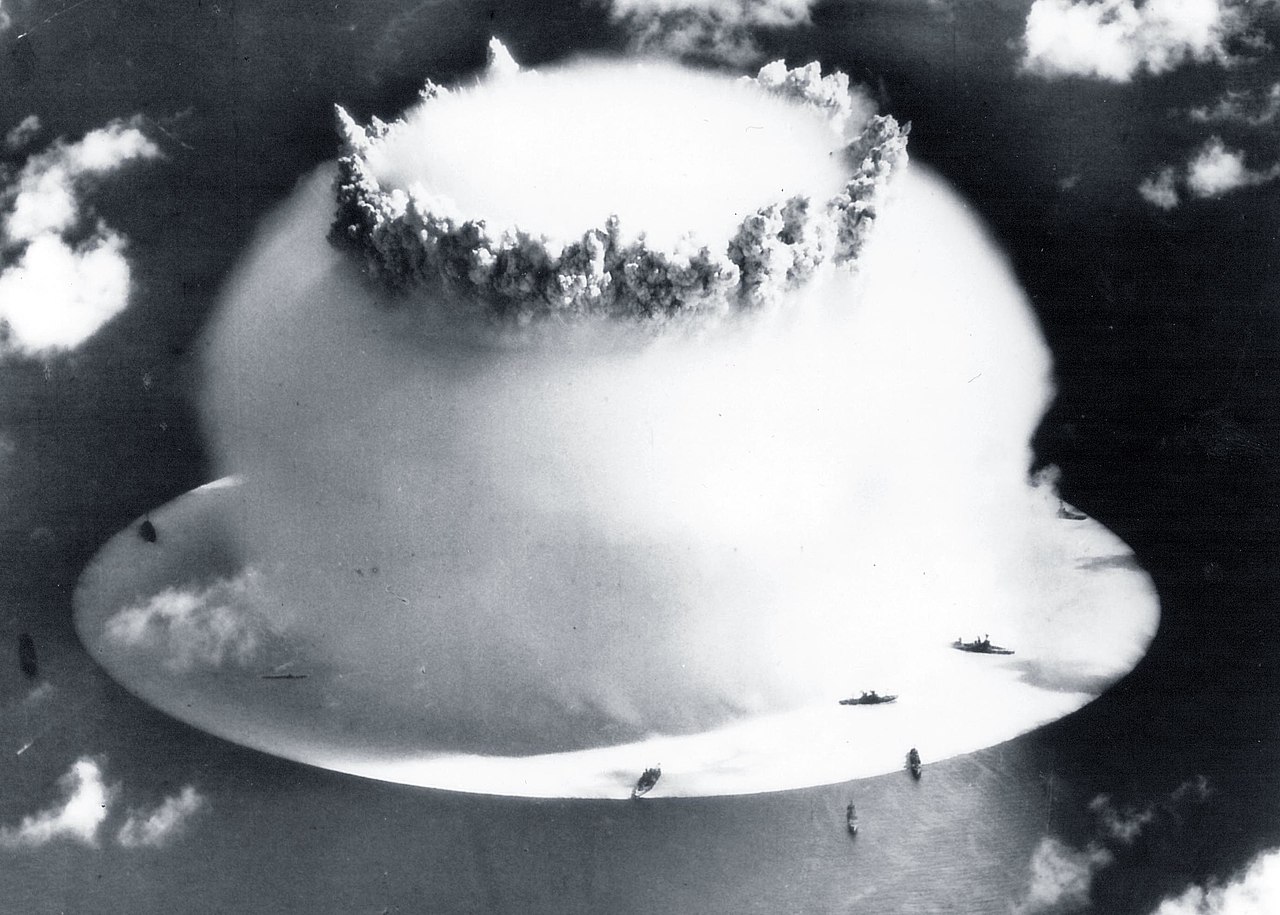
The iconic image of the Baker shot at Bikini
The Navy won a critical early battle when Vice Admiral William Blandy was selected to head the tests instead of the Army's choice, Leslie Groves, who had run the Manhattan Project. The targets would be some of the massive fleet of obsolete or captured ships left over from the war, everything from battleships to submarines and transports. Three tests were planned: Able, an airburst test; Baker, a shallow underwater burst; and Charlie, a deep underwater test to investigate the efficacy of nuclear depth charges. They would have to be carried out quickly, before the men required returned to civilian life. The site had to be somewhere controlled by the United States, far away from any major population centers and possessed of predictable weather patterns to minimize the danger of radioactive contamination to the men of the Task Force. The location chosen was Bikini Atoll, in the Marshall Islands.1
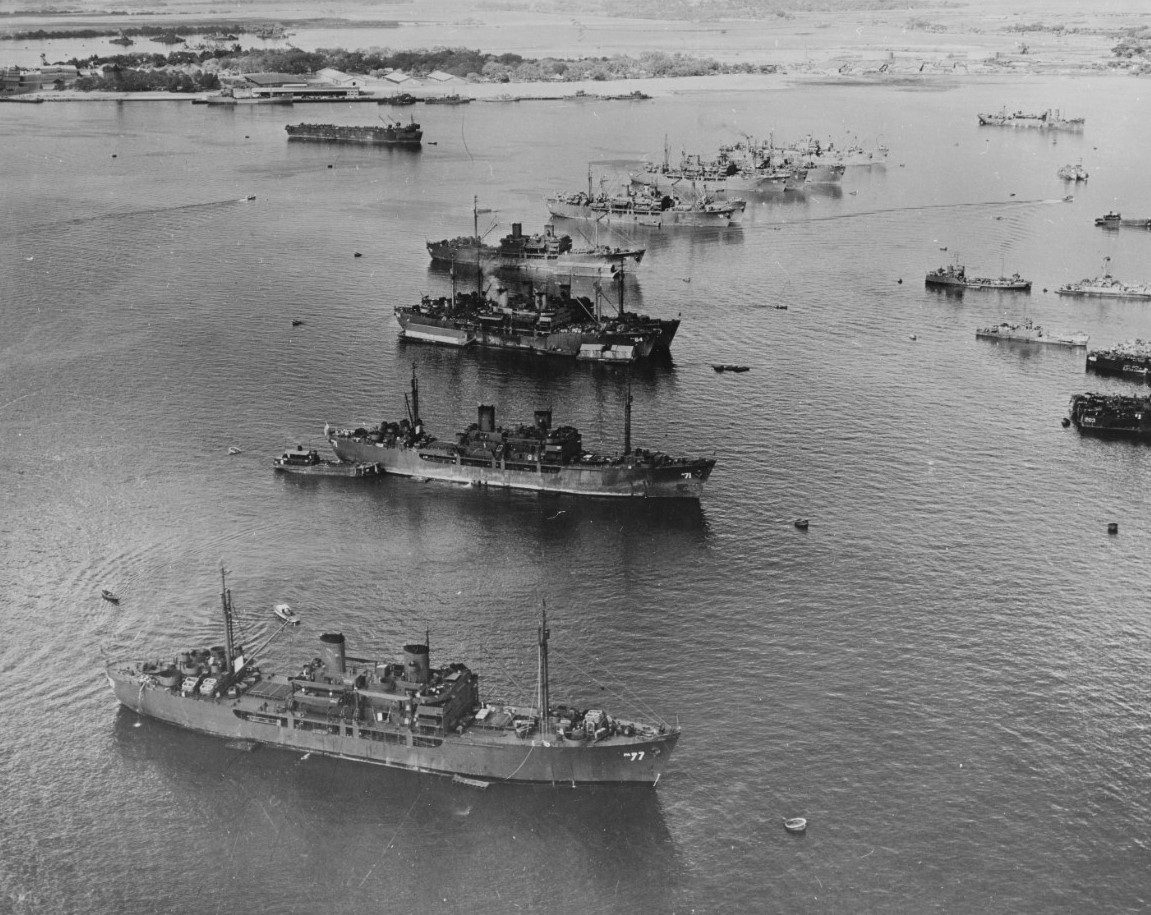
Ships are prepped for Crossroads at Pearl Harbor
The tests were not without controversy. Many diplomats and scientists opposed them, the former because they believed the tests would compromise efforts to place nuclear energy under international control, the latter because of the possible environmental impacts, particularly for the underwater tests, which could produce a witch's brew of radioactive materials. Many also pointed out that tests on empty ships could only demonstrate the survivability of the vessels themselves, and that the radiation from the bomb could still harm the crew. In response, Blandy made plans to use animals to study the problems of radiation exposure, angering animal-rights activists, too.2 Also angered were veterans and Congressmen from New York and Pennsylvania, who were informed that their state's namesake battleships could not be spared for preservation as museums.
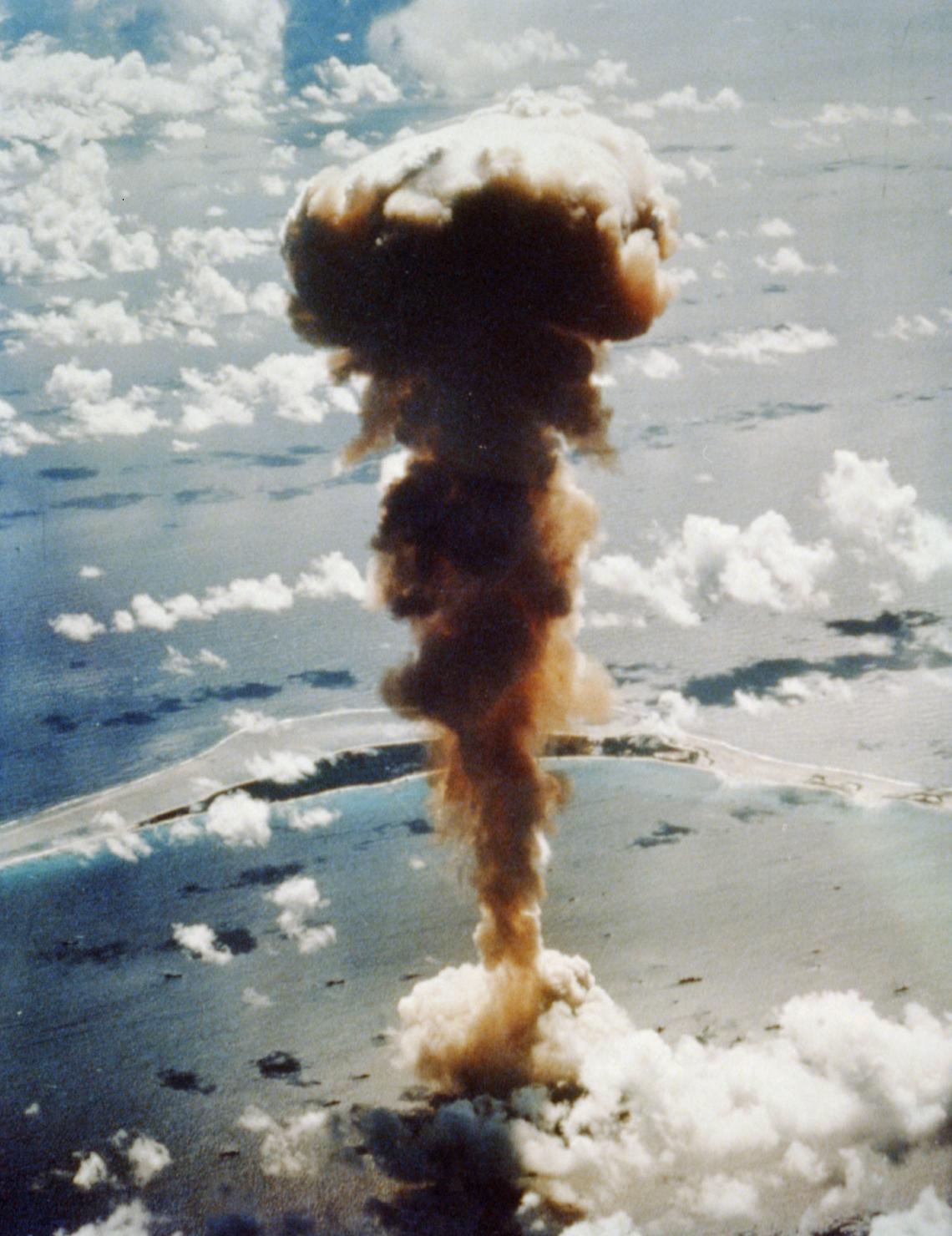
The mushroom cloud of Able shot
The tests would be a massive undertaking, with Joint Task Force One, the unit responsible, eventually composing more than 150 ships, 42,000 men and 150 aircraft. 167 Bikini Islanders had to be relocated to nearby Rongerik Atoll, and it took 100 tons of explosives to clear the necessary channels into the lagoon, where the 94 ships of the target fleet would be anchored. Besides New York and Pennsylvania, notable ships in the target fleet included carriers Saratoga and Independence and battleships Nevada and Arkansas, as well as the captured Japanese Nagato. The cruiser fleet was also multinational, with the German Prinz Eugen, the Japanese Sakawa, and the American Pensacola and Salt Lake City. 17 destroyers and 8 submarines joined them, along with a flotilla of transport ships and landing craft. Three concrete-hulled vessels were included to gain more information on the effects of bombs against structures. This armada, by most counts the world's fifth or sixth largest navy, was assembled at Bikini in May and June of 1946. They were packed close, with 20 ships within a thousand yards of the target, an area that would hold only a single capital ship in combat formation. Before they were dispatched to Bikini, the ships were stripped of valuable equipment, made watertight and fitted with samples of the payload of fuel, ammunition, and supplies they would carry in action. Airplanes and military equipment were mounted on deck to gain even more information about the effects of the bomb. 10,000 instruments would monitor every aspect of the test. They would be joined in their observation by Secretary of the Navy James Forrestal, 15 members of Congress, observers from 11 countries, and 175 journalists, who watched from 10 miles outside the lagoon for safety reasons.
At 9:00 on July 1st, 1946, a B-29 flying over Bikini lagoon dropped a Mark III atomic bomb, a near-clone of the Fat Man device used against Nagasaki. The bomb, named Gilda after a recent Rita Hayworth film, was aimed at Nevada, which had been painted orange to mark her from the air. However, for reasons that have never been entirely clear, the bomb missed by 710 yards, detonating 520' over the attack transport Gilliam, releasing energy equivalent to 23,000 tons of TNT. The miss took the bomb nearly out of the main group of targets, greatly reducing the damage done. Gilliam, sunk almost instantly, was joined on the bottom by attack transport Carlisle. Destroyers Anderson and Lamson sunk a few hours later, while the Japanese cruiser Sakawa went down the next day, despite an attempt to beach her.
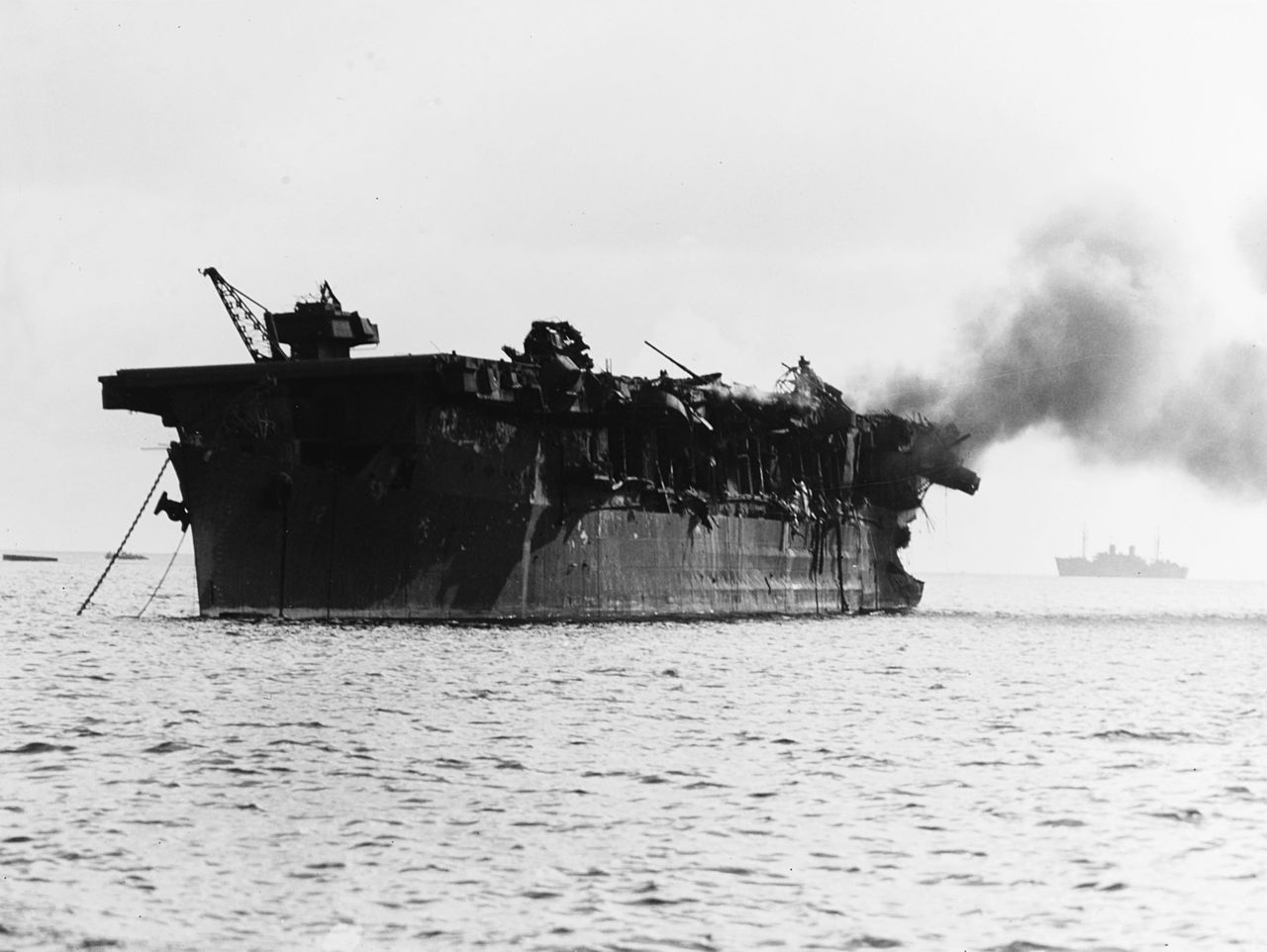
Independence afire after the Able test
Despite the low toll of ships sunk, the bomb did extensive damage. Particularly hard-hit was light carrier Independence, less than half a mile from the zero point. Her flight-deck was buckled and broken by the blast, the elevators were blown overboard, the plating above the waterline was dished in, and structural beams ripped loose from the skin. A fire burned in the hangar deck, and all 25 airplanes parked on the flight deck had been blown overboard. The island and funnels were partially demolished. Arkansas was also close by, and besides a minor deck fire, she suffered extensive blast damage topside, which would have put her fully out of action. By a quirk of fate, Nevada, stern-on to the blast, escaped with only moderate damage, some dishing of the deck and blackened paint.
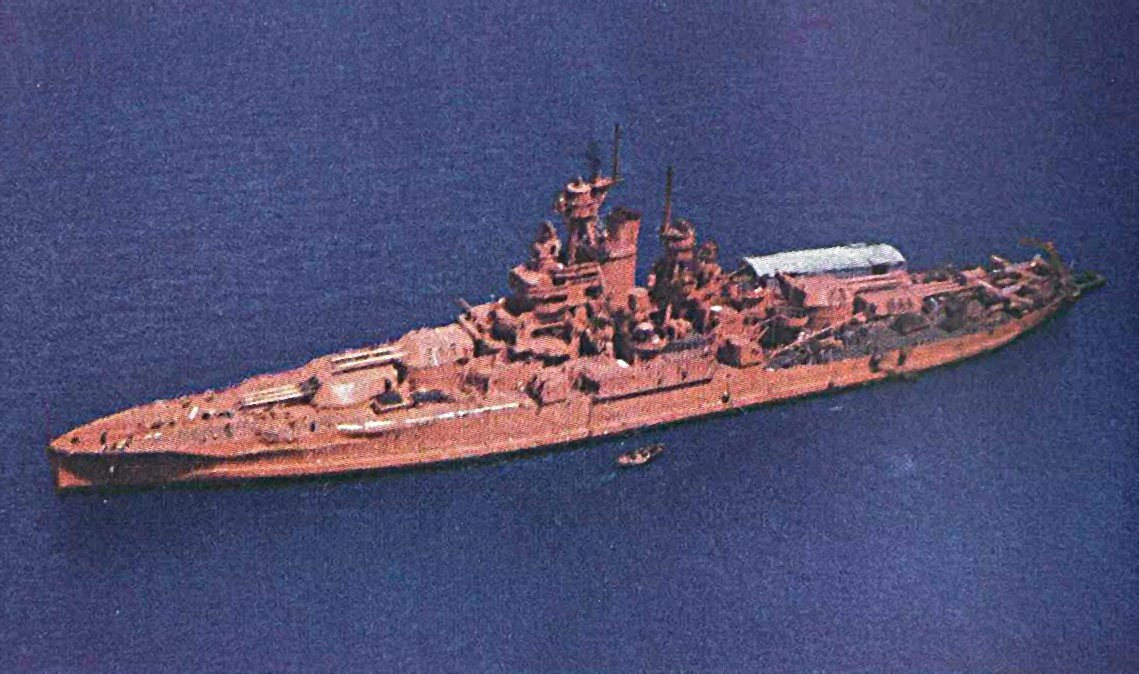
Nevada painted orange for the test
But the other threat was radiation, and there, the story was not so rosy. While the goats deep inside Nevada survived the initial test perfectly well, all died within a few days due to radiation poisoning. In fact, the unprotected goats received nearly 100,000 rems, 20 times the dose required to immediately incapacitate exposed humans, and approximately 100 times the dose that results in certain death. Even the shielding of a ship's hull would do little to protect the crew at such short ranges, although the odds of survival were reasonable outside of a mile or so. As Abel was an airburst and the fireball never touched the ground, there was little residual radioactive contamination. The ships themselves were not made radioactive by the blast, and all were reboarded within a day or two.
The second test was conducted on July 25th, with a bomb known as Helen of Bikini, suspended 90 feet below LSM-60, a mechanized landing craft. This was halfway between the surface and the seabed, and when it went off, it produced some of the most dramatic and recognizable images of the nuclear age. The energy released drove a shockwave through the lagoon, crushing the hulls of nearby ships, blowing two million tons of water into the skies over Bikini, and digging a crater 30' deep and 600 yards across in the seafloor. The shockwave passed into the air, and the drop in pressure behind it created condensation in the humid air, a ball that became known as a Wilson Cloud. LSM-60 was completely vaporized, and Arkansas, 225 yards away, was surrounded by the rising column of water. Popular legend says that the ship was thrown into the air, but more careful analysis does not support this, and she was instead immediately capsized, with her hull driven in as much as 6' in places, and then shoved into the bottom by the falling water.
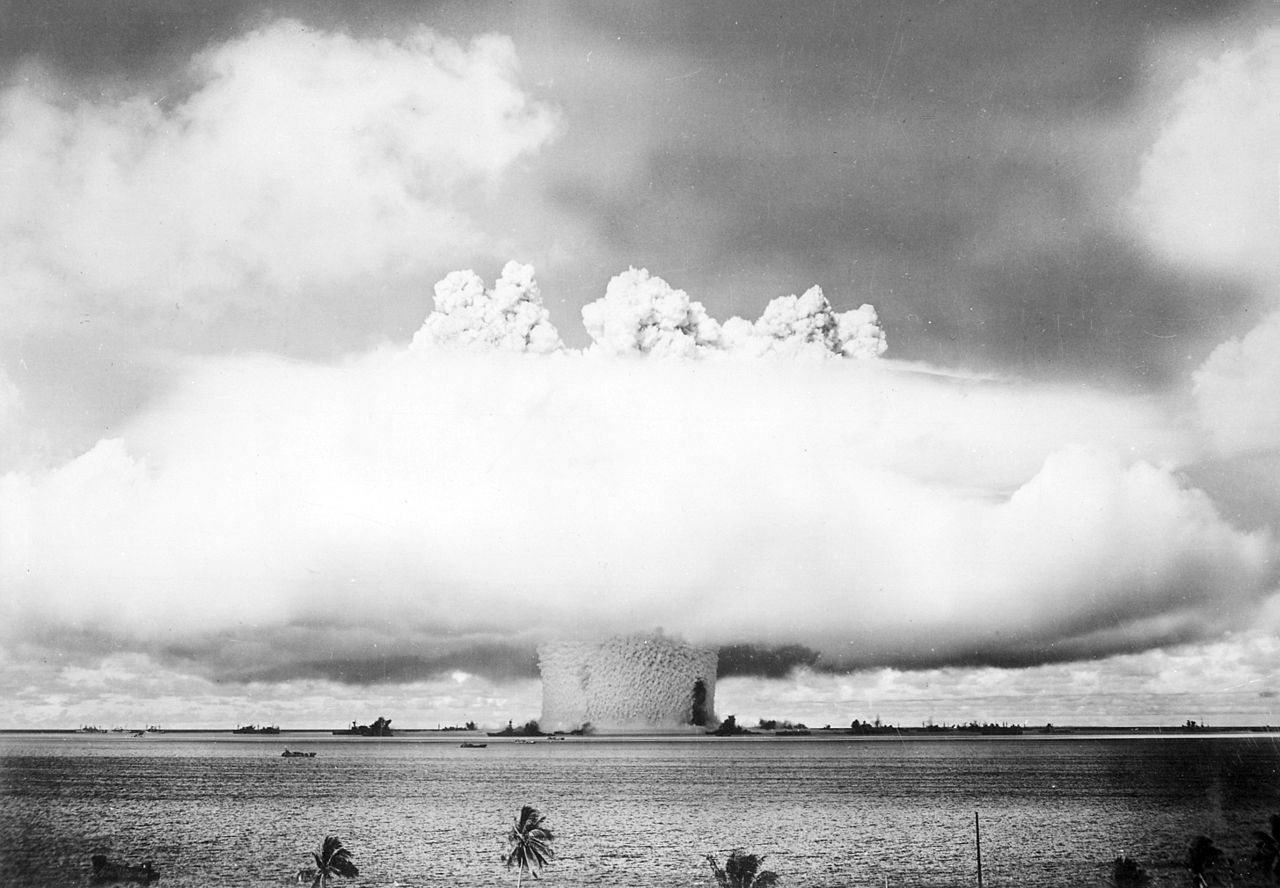
The water column climbs skyward, with Arkansas leaving a dark streak in it.
Three submarines, Pilotfish, Apogon and Skipjack, were submerged within a thousand yards of the bomb, and were sunk almost immediately, their thick hulls no match for the bomb's force. Saratoga was about 350 yards away from the zero point. The first wave, which crested at a height of 94', hit her broadside, and drove her back another 450 yards, while the crest of the second wave collapsed over her, crushing her superstructure. Beloved Sara fought for life, staying afloat for almost 8 hours after the detonation. The first crew into the lagoon made a valiant effort to tow her ashore, only to be driven back by the radiation unleashed by the bomb.
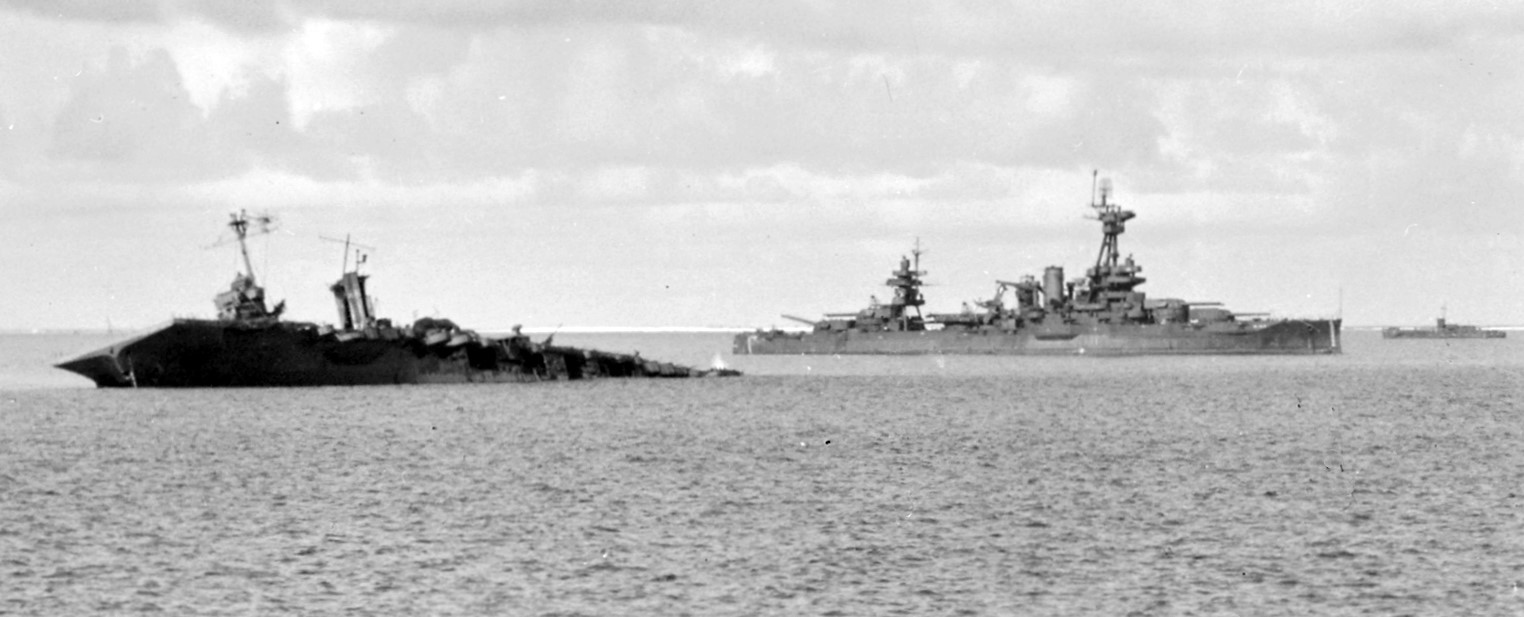
Saratoga sinking into the lagoon, with New York behind her
For it was radiation that would be the greatest consequence of the Baker test. The falling water drove out a cloud of radioactive spray known as the base surge, carrying with it leftover plutonium and a witch's brew of fission byproducts. These coated the target fleet, leaving all but 9 of the 95 vessels badly contaminated with radiation. Some level of contamination had been expected, but the drone boats and planes that swept in found it much higher than predicted, with levels that would kill a person after half an hour or less of exposure. Despite this, salvage and inspection crews were ordered in, and a dozen of the target ships were briefly reboarded on the afternoon of the test. However, there was still a great deal of contamination in the lagoon, and the support fleet was repeatedly forced to reposition as shifting currents raised the radiation level in the areas where they were anchored.
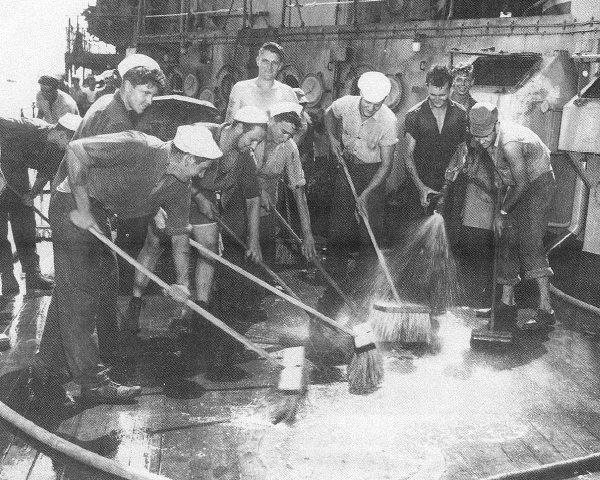
Sailors attempt to decontaminate a ship after Baker
But the problems were just beginning. Even days after the test, many of the ships remained sufficiently radioactive that the daily limit of .1 Roentgen would be reached in minutes. As a result, leaks and minor blast damage lead to several ships sinking, most notably Nagato, which went down four days after the blast. Prinz Eugen survived for six months, finally succumbing to otherwise-normal leakage on December 22nd. Decontamination efforts ranged from spraying of contaminated lagoon water by salvage tugs to scrubbing with water, soap, and lye, but nothing short of sandblasting to bare metal and repainting would actually remove it. To make matters worse, the support ships were authorized to run their distilling plants inside the lagoon, contaminating their saltwater systems with radioactive material. Eventually, Blandy was convinced to call off the decontamination effort, partially by the detection of plutonium, which couldn't be picked up by the Task Force's Geiger counters,3 in areas free of detectable radioactivity, and the presentation of an X-ray created by simply placing a contaminated fish on a piece of X-ray film.
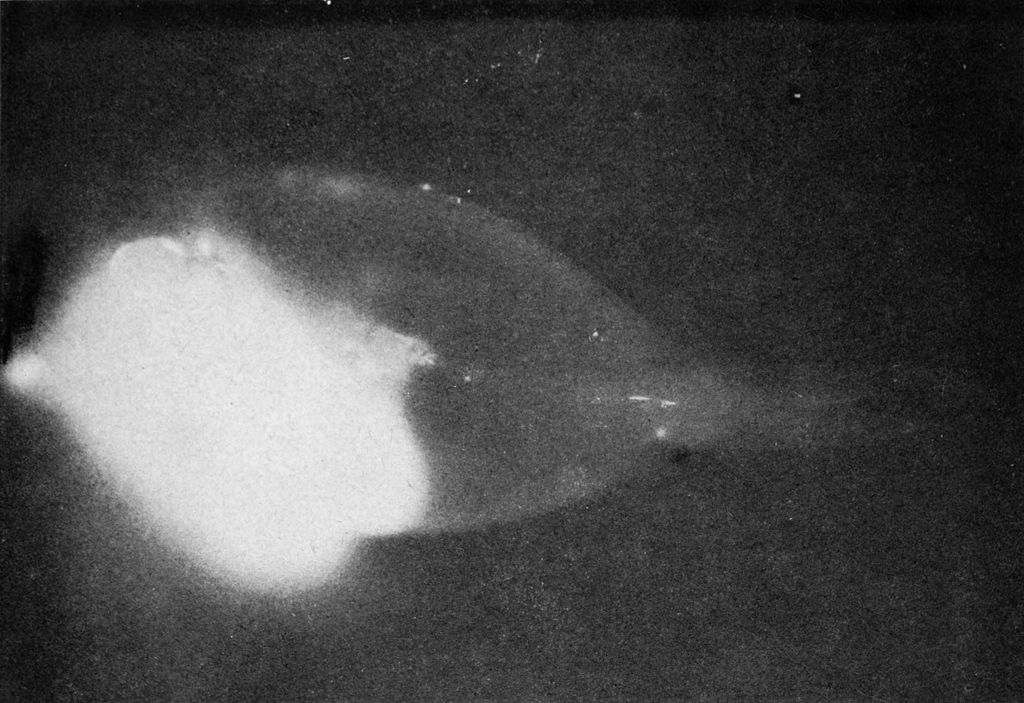
The fish X-ray that convinced Blandy to end decontamination
As a result of this, the plan to sail most of the target ships home in triumph was abandoned, as was the Charlie shot, which would have reused some of the target ships. Despite this, the Navy's main purpose of blunting the attack on its relevance was achieved, although the newly-independent Air Force would try again in a few years. Most of the vessels were ultimately used as target ships or otherwise scuttled, including Nevada, New York and Pennsylvania. The exact impact on the personnel of the support fleet is less certain, but it appears to have shortened the life of the average participant by about 3 months. Bikini was used for several later nuclear tests, most notably the 1954 Castle Bravo, the second American thermonuclear weapons test. The island and surrounding waters remain so contaminated that the population has not returned, although divers do sometimes venture to the atoll to visit the ghost fleet that was sacrificed so the Navy could learn how to fight a nuclear war.
1 Yes, there is a connection to the famous swimsuit, which was introduced to the public just days after the Able test, and was expected to have an explosive effect on the world of fashion. ⇑
2 Some of the letters received suggested that German and Japanese war criminals be substituted for the animals, a revealing glimpse of feeling in the immediate postwar months. ⇑
3 Pu emits alpha particles, which have very little penetration ability, and thus are hard to detect. However, it's exceedingly dangerous if it gets into the body. ⇑

Comments
Well it sounds like they really did learn a lot of valuable information. That the bombs could produce much more contamination than they thought, and that a nuclear war would be much more deadly than just big explosions. Better to learn that sooner than later.
starts reading about the background of those politicians. It's still difficult to grasp the idea that a significant chunk of Harvard grads and faculty were all in favor of giving the bomb to the Soviet Union.
The plan wasn't to give the bomb to the Soviets directly. It was to give the UN an atomic monopoly. But yeah, in retrospect, it looks like the sort of thing only a crazy person would come up with.